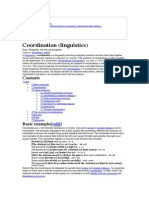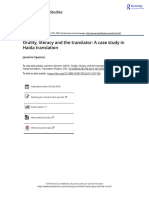Translating Culture vs. Cultural Translation
Translating Culture vs. Cultural Translation
Uploaded by
alolapukaCopyright:
Available Formats
Translating Culture vs. Cultural Translation
Translating Culture vs. Cultural Translation
Uploaded by
alolapukaCopyright
Available Formats
Share this document
Did you find this document useful?
Is this content inappropriate?
Copyright:
Available Formats
Translating Culture vs. Cultural Translation
Translating Culture vs. Cultural Translation
Uploaded by
alolapukaCopyright:
Available Formats
Harish Trivedi 6 American pop.
Nearly all Kureishis works are set in London or in the suburbia, and one of them, titled Sleep with Me (1999), has only white British characters.The only difficulty with such demonstrable Britishness of Kureishi is that in theliterary and cultural world of London in the 1970s, when Kureishi was beginning to comeinto his own as a writer, he was nevertheless slotted by commissioning editors for theatre andtelevision into the role of an Asian cultural translator. As he recounts,they required storiesabout the new [immigrant] British communities, by cultural translators, as it were, tointerpret one side to the other, and though Kureishi knew that as a non-migrant truebornBritisher he was not by upbringing and sensibility the sort of writer best-suited to this kindof work, he did it nevertheless because I just knew I was being paid to write (qted. inRanasinha 12). In this version, cultural translation is not so much the need of the migrant,as Bhabha makes it out to be, but rather more a requirement of the society and culture to which the migrant has travelled; it is a hegemonic Western demand and necessity.For an even more thoroughgoing and self-induced example of a cultural translator, we may look at Jhumpa Lahiri, whose first book of fiction, Interpreter of Maladies: Stories of Bengal, Boston and Beyond (1999), made her the first Indian-born writer to win the Pulitzerprize for fiction. She was born of Bengali parents in London, grew up in America, becamean American citizen at age 18, is by her own admission not really a bilingual though she would like to think she was, and has written fiction not only about Indians in America butalso some stories about Indian still living in India. In answer to the criticism that herknowledge of India as reflected in these stories is demonstrably erroneous and defective, shehas said, I am the first person to admit that my knowledge of India is limited, the way in which all translations are (Lahiri 118). This gratuitous trope is sustained and furtherhighlighted by her going on to say that her representation of India is in fact her translationof India (Lahiri 118). It soon transpires that not only is Lahiri as author a translator but soare the fictional personages she translates into existence: Almost all of my characters aretranslators, insofar as they must make sense of the foreign to survive (Lahiri 120). Thisechoes, probably unwittingly, the Benjaminian-Derridean sur-vivre , in the sense seized uponby Bhabha, just as Lahiris assertion that translation is not only a finite linguistic act but anongoing cultural one (Lahiri 120) reiterates Bhabhas central premise. And at the conclusionof this essay which Lahiri clearly means to serve as her manifesto and apologia, she declares: And whether I write as an American or an Indian, about things American orIndian or otherwise, one thing remains constant: I translate, therefore I am(Lahiri 120). And this from a writer who, like Kureishi, has never translated a word, and who admits that when one of her short stories was published in translation into Bengali, which is her parentsmother-tongue (even if it was not quite her own) and which was therefore the (other?)language of her childhood, she could not understand the translated version or as she herself put it, seeming to shift the responsibility from herself on to the translation, it provedinaccessible to me (Lahiri 120).If this is cultural translation, we perhaps need to worry about the very meaning of the word translation. One wonders why translation should be the word of choice in ac o l l o c a t i o n s u c h a s c u l t u r a l t r a n s l a t i o n i n t h i s n e w s e n s e w h e n p e r f e c t l y g o o d a n d theoretically sanctioned words for this new phenomenon, such as migrancy, exile or diasporaare already available and current. But given the usurpation that has taken place, it may betime for all good men and true, and of course women, who have ever practised literary translation, or even read translation with any awareness of it being translation, to unite andtake out a patent on the word translation, if it is not already too late to do so. Harish Trivedi 7S u c h a b u s e o r , i n t h e o r e t i c a l e u p h e m i s m , s u c h c a t a c h r e s t i c u s e , o f t h e t e r m translation is, as it happens, mirrored and magnified through a semantic explosion ordilution in popular, non-theoretical usage as well. Newspapers constantly speak of how t h r e a t s c o u l d t r a n s l a t e into action or popularity into votes; there is a book titled Translating L. A ., which apparently means no more than describing L.A., and Susan Bassnettherself has recently written that Edwin Gentzlers book Contemporary Translation Theories isnot only a critical survey but effectively also a translation, for the author transforms a wholerange of complex theoretical material into accessible language (in Gentzler vi). But it is of c o u r s e t h e s a m e l a n g u a g e , E n g l i s h , i n w h i c h s u c h t h e o r e t i c a l c o m p l e x i t y a n d s u c h accessibility both exist. Even when these are not instances of cultural translation in thesense expounded by Bhabha, these are still instances of a kind of translation which does notinvolve two texts, or even one text, and certainly not more than one language. These are stillexamples of what Bhabha, with his usual felicity, has in another context called non-substantive translation (in personal conversation). One could perhaps go a step further and, without any attempt at matching felicity, call it simply non-translation.In conclusion, one may suggest that there is an urgent need perhaps to protect andp r e s e r v e s o m e l i t t l e s p a c e i n t h i s postcolonial-postmodernist world, where newnessconstantly enters through cultural t r a n s l a t i o n , f o r s o m e o l d a n d o l d - f a s h i o n e d l i t e r a r y translation. For, if such bilingual bicultural ground is eroded away, we shall sooner thanlater end up with a wholly translated, monolingual, monocultural, monolithic world. Andthen those of us who are still bilingual, and who are still untranslated from our own nativeground to an alien shore, will nevertheless have been translated against our will and againstour grain. Further, translation itself
would have been untranslated or detranslated, for it would have come under erasure in a sense rather less deconstructive than Derridas butplainly more destructive. The postcolonial would have thoroughly colonized translation, fortranslation in the sense that we have known and cherished it, and the value it possessed as aninstrument of discovery and exchange, would have ceased to exist. Rather than help usencounter and experience other cultures, translation would have been assimilated in just onemonolingual global culture. All the recent talk of multiculturalism relates, it may be noted, not to the many different cultures located all over the world, but merely to expedient social management of as m a l l s a m p l e o f m i g r a n t s f r o m s o m e o f t h e s e c u l t u r e s w h o h a v e a c t u a l l y d i s l o c a t e d themselves and arrived in the First World, and who now must be melted down in that pot,or tossed in that salad, or fitted as an odd little piece into that mosaic. These stray littleflotsam and jetsam of world culture which have been washed up on their shores are quiteenough for the taste of the First World. Migrancy, often upper-class elite migrancy as forexample from India, has already provided the First World with as much newness as it needsand can cope with, and given it the illusion that this tiny fraction of the Third World hasalready made the First World the whole world, the only world there is. Those of us stilllocated on our own home turf and in our own cultures and speaking our own languages canno longer be seen or heard. All the politically correct talk of ecodiversity and biodiversity concerns a harmless and less problematic level of species below the human; there is nocorresponding desire that one can discern for cultural or linguistic diversity. Funds from allover the world are being poured in to preserve and propagate the Royal Bengal Tiger, forexample, which is declared to be an endangered species, but no such support is forthcomingfor the Indian languages, which seem to be equally endangered by the increasing decimationof world languages by the one all-devouring, multinational, global language, English. Itoccurs to me that no international agency might want to save the Royal Bengal Tiger if itactually roared in Bengali; there may be the little problem then of having to translate it into Harish Trivedi 8English first. In any case, the World Wildlife Fund is committed to saving only wild life,not cultured life.In this brave new dystopian world of cultural translation, translation ironically wouldhave been translated back to its literal, etymological meaning, of human migration. In early Christian use of the term, in fact, translation in the sense of being borne across took place when a dead person was bodily transported to the next world, or on a rare occasion when hisbody was transferred from one grave to another, as happened famously in the case of Thomasa Beckett, who was actually murdered and initially buried near the crypt of the Canterbury Cathedral but then, about 150 years later, when the trickle of pilgrims had swollen into amainstream, moved and buried again within the same cathedral in the grand new Trinity Chapel. In both these senses, of bodily removal to the next world or to the next grave, weare talking of someone who is truly dead and buried. The many indigenous languages of the world and the channel of exchange between them, translation, may seem headed for the samefate in the time of cultural translation: to be dead and buried.* WORKS CITEDBassnett, Susan. (1980) 2002. Translation Studies . London: Routledge.Bassnett, Susan. 1993. Comparative Literature: A Critical Introduction . Oxford:Blackwell.Bassnett, Susan and Andre Lefevere. 1998. Constructing Cultures: Essays on Literary Translation . Clevedon: Multilingual Matters.Bhabha, Homi. 1994. The Location of Culture . London: Routledge.Catford, J. C. 1965. A Linguistic Theory of Translation: An Essay in Applied Linguistics London: Oxford University Press.Gentzler, Edwin. (1993) 2001. Contemporary Translation Theories . Clevedon:Multilingual Matters.Lahiri, Jhumpa. 2000. My Intimate Alien. Outlook (New Delhi), special annualissue on Stree [Woman], pp. 116-20.Niranjana, Tejaswini. 1992. Siting Translation: History, Post-Structuralism and the Colonial Context . Berkeley: University of California Press.Ranasinha, Ruvani. 2001. Hanif Kureishi . (Writers and their Work series).London: Northcote House.Rushdie, Salman. 1991. Imaginary Homelands: Essays and Criticism 1981-91 .London: Granta Books.* Parts and versions of this essay were delivered at the universities of Iowa, Essex, Warwick a n d L o n d o n , a n d I a m g r a t e f u l t o m y a u d i e n c e s f o r m a n y h e l p f u l o b s e r v a t i o n s a n d suggestions.
You might also like
- Translating Cultures. Translating Iran. Domestication and ForeignizationDocument14 pagesTranslating Cultures. Translating Iran. Domestication and Foreignizationmiss_barbarona100% (2)
- Colloquial French - The Complete Course For Beginners (Colloquial Series) PDFDocument287 pagesColloquial French - The Complete Course For Beginners (Colloquial Series) PDFlarathiago100% (8)
- The Politics of Translation by Gayatri SpivakDocument22 pagesThe Politics of Translation by Gayatri Spivakswetalina priyadarshiniNo ratings yet
- Grammar Inversion and FrontingDocument7 pagesGrammar Inversion and Frontingalolapuka60% (5)
- Science Activity Completion ReportDocument4 pagesScience Activity Completion ReportJess DevarasNo ratings yet
- Fogel, Joshua A. - Recent Translation TheoryDocument7 pagesFogel, Joshua A. - Recent Translation TheoryRafael Flores PazNo ratings yet
- Borrowed Tongues: Life Writing, Migration, and TranslationFrom EverandBorrowed Tongues: Life Writing, Migration, and TranslationNo ratings yet
- Power DifferentialsDocument4 pagesPower DifferentialsAna Clara ValdezNo ratings yet
- Coordination (Linguistics) - Wikipedia, The Free Encyclopedia - HTMLDocument9 pagesCoordination (Linguistics) - Wikipedia, The Free Encyclopedia - HTMLalolapukaNo ratings yet
- Bassnett Susan The Translator As WriterDocument16 pagesBassnett Susan The Translator As Writeralolapuka0% (1)
- Leonora Carrington-The Talismanic LensDocument3 pagesLeonora Carrington-The Talismanic LensalolapukaNo ratings yet
- Labov. Some Further Steps in Narrative AnalysisDocument16 pagesLabov. Some Further Steps in Narrative AnalysisVizente Bizantino100% (1)
- KBlectureDocument24 pagesKBlectureEiriniEnypnioNo ratings yet
- 08 Robert J.C. YoungDocument21 pages08 Robert J.C. YoungjonnyblaiseNo ratings yet
- Burke 2007Document10 pagesBurke 2007Fábio marianoNo ratings yet
- Burke 2007Document10 pagesBurke 2007Fábio marianoNo ratings yet
- Crossing Borders: Stories and Essays about TranslationFrom EverandCrossing Borders: Stories and Essays about TranslationNo ratings yet
- Article 9Document9 pagesArticle 9joshita.guptaNo ratings yet
- Cultural Translation, Universality and Emancipation: Gabriel DolsDocument14 pagesCultural Translation, Universality and Emancipation: Gabriel DolsACNo ratings yet
- Global Translation: The Dream of A Translation Tower of BabelDocument5 pagesGlobal Translation: The Dream of A Translation Tower of BabelcinburNo ratings yet
- Lec 14Document11 pagesLec 14Drunken MasterNo ratings yet
- Anticolonial and Anti Imperial TranslatiDocument34 pagesAnticolonial and Anti Imperial Translativictoriamadison006No ratings yet
- Poetics of History: Rousseau and the Theater of Originary MimesisFrom EverandPoetics of History: Rousseau and the Theater of Originary MimesisNo ratings yet
- Young Fanon and Enigma of Cultural Translation - PermissionDocument12 pagesYoung Fanon and Enigma of Cultural Translation - PermissionYasser MunifNo ratings yet
- Jorge Luis Borges and The Debate of TranslationDocument7 pagesJorge Luis Borges and The Debate of TranslationAlexandru Neagoe100% (1)
- 03 Genotiva Does Regional Literature ExistDocument6 pages03 Genotiva Does Regional Literature ExistImee Princess Dianna ReyesNo ratings yet
- Akhil Katyal - Three StoriesDocument10 pagesAkhil Katyal - Three StorieshikariisetsuyaNo ratings yet
- Lost in TranslationDocument15 pagesLost in TranslationDanuta SeniucNo ratings yet
- Postcolonialism: Ngugi, Achebe and FanonDocument4 pagesPostcolonialism: Ngugi, Achebe and FanonSamriddhi BhatnagarNo ratings yet
- Luisa Capetillo in Translation: NOTAS PARA UN TESTIMONIODocument10 pagesLuisa Capetillo in Translation: NOTAS PARA UN TESTIMONIOLuis Agosto-LeducNo ratings yet
- The Orange Was Dry and Shriveled KanafanDocument12 pagesThe Orange Was Dry and Shriveled KanafanInsaf AliNo ratings yet
- In 1990 The Two Theoretical Bassnett and Lefevere Suggested A Breakthrough in The Field of Translation StudiesDocument11 pagesIn 1990 The Two Theoretical Bassnett and Lefevere Suggested A Breakthrough in The Field of Translation StudiesElvira GiannettiNo ratings yet
- The Problems of Language in Cross Cultural StudiesDocument22 pagesThe Problems of Language in Cross Cultural StudiesMuhammed100% (1)
- prezkiTXT 31 40Document10 pagesprezkiTXT 31 40adres900No ratings yet
- Diplom IshDocument22 pagesDiplom IshmohiryusuNo ratings yet
- Singular Universals Rabindranath TagoreDocument14 pagesSingular Universals Rabindranath TagoreTen GyalNo ratings yet
- The Man Between: Michael Henry Heim and a Life in TranslationFrom EverandThe Man Between: Michael Henry Heim and a Life in TranslationNo ratings yet
- Bhatnagar ToCDocument57 pagesBhatnagar ToCrashmi bhatnagarNo ratings yet
- Geez MindDocument3 pagesGeez MindGeez Bemesmer-LayNo ratings yet
- Quarterly Essay 52 Found in Translation: In Praise of a Plural WorldFrom EverandQuarterly Essay 52 Found in Translation: In Praise of a Plural WorldNo ratings yet
- Translation and Nation: Negotiating "China" in the Translations of Lin Shu, Yan Fu and Liang QichaoFrom EverandTranslation and Nation: Negotiating "China" in the Translations of Lin Shu, Yan Fu and Liang QichaoNo ratings yet
- The Role of Self-Translation in The Decolonisa-Tion Process of African CountriesDocument19 pagesThe Role of Self-Translation in The Decolonisa-Tion Process of African CountriesshantanumajeeNo ratings yet
- RAFT LimitsTranslationMethod 2012Document51 pagesRAFT LimitsTranslationMethod 2012mmjamberNo ratings yet
- Spencer 2018Document18 pagesSpencer 2018raulgarciazarateNo ratings yet
- Cultural Translation and The ExorcistDocument24 pagesCultural Translation and The ExorcistJai SinghNo ratings yet
- L - 07 Chapter 2Document44 pagesL - 07 Chapter 2English ScholarNo ratings yet
- The Disengaged Escapist Edited For PresentationDocument12 pagesThe Disengaged Escapist Edited For PresentationDebkamal GangulyNo ratings yet
- OnDalitWritingandUntranslatability Seminar PrashantIngoleDocument6 pagesOnDalitWritingandUntranslatability Seminar PrashantIngoleanveshtech teluguNo ratings yet
- Lionnet - 1992 - 'Logiques Métisses' Cultural Appropriation and Postcolonial RepresentationsDocument22 pagesLionnet - 1992 - 'Logiques Métisses' Cultural Appropriation and Postcolonial RepresentationsJohnNo ratings yet
- REFLECTIONS Rethinking TranslationDocument5 pagesREFLECTIONS Rethinking TranslationShaliniNo ratings yet
- George Steiner'S Philosophy: Translation As A New ParadigmaDocument12 pagesGeorge Steiner'S Philosophy: Translation As A New ParadigmaAryatyago MongeNo ratings yet
- After Babel Aspects of Language and TranDocument2 pagesAfter Babel Aspects of Language and TranAryatyago MongeNo ratings yet
- Cultural Translation An Introduction To The ProblemDocument3 pagesCultural Translation An Introduction To The ProblemjeremíasbourbotteNo ratings yet
- Problems of Translating Cultural TerminologyDocument19 pagesProblems of Translating Cultural TerminologyvibgiorNo ratings yet
- Kwaku A. Gyasi, The African Writer As TranslatorDocument17 pagesKwaku A. Gyasi, The African Writer As TranslatorGhe CriNo ratings yet
- Writing Between CulturesDocument48 pagesWriting Between CulturesFlo FlolikeariverNo ratings yet
- Transnational LiteratureDocument14 pagesTransnational LiteratureKelly ChanNo ratings yet
- Moji New 2015Document20 pagesMoji New 2015eliel nangoNo ratings yet
- Taking FlightDocument68 pagesTaking FlightEnglish PENNo ratings yet
- Notes 2Document8 pagesNotes 2Andria SumeshNo ratings yet
- Is There An Indian School of TranslationDocument15 pagesIs There An Indian School of Translationpriyanka mistryNo ratings yet
- The Cultural Capital, The Textual Grid, and The Postcolonial Translation TheoryDocument11 pagesThe Cultural Capital, The Textual Grid, and The Postcolonial Translation TheorygokhansimskkNo ratings yet
- Translatin The WorldDocument3 pagesTranslatin The Worldsandrashalom2No ratings yet
- Pelo Magazine - Issue 038Document52 pagesPelo Magazine - Issue 038alolapukaNo ratings yet
- Cabin Pressure Series 1, Episode 3 - CremonaDocument19 pagesCabin Pressure Series 1, Episode 3 - CremonaalolapukaNo ratings yet
- John Finnemore's Souvenir Programme, Episode 3, Season 1 TranscriptDocument11 pagesJohn Finnemore's Souvenir Programme, Episode 3, Season 1 TranscriptalolapukaNo ratings yet
- John Finnemore's Souvenir Programme Episode 1 Season 1 TranscriptDocument14 pagesJohn Finnemore's Souvenir Programme Episode 1 Season 1 TranscriptalolapukaNo ratings yet
- Lewis Carroll in NumberlandDocument248 pagesLewis Carroll in NumberlandalolapukaNo ratings yet
- John Finnemore's Souvenir Programme Episode 1 Season 1 TranscriptDocument14 pagesJohn Finnemore's Souvenir Programme Episode 1 Season 1 TranscriptalolapukaNo ratings yet
- John Finnemore's Souvenir Programme, Episode 3, Season 1 TranscriptDocument11 pagesJohn Finnemore's Souvenir Programme, Episode 3, Season 1 TranscriptalolapukaNo ratings yet
- Stephen Fry Takes On The Language PedantsDocument2 pagesStephen Fry Takes On The Language PedantsalolapukaNo ratings yet
- The Three GarridebsDocument305 pagesThe Three GarridebsalolapukaNo ratings yet
- MY MOTHER Is A COW - by Leonora Carrington - A MonologueDocument11 pagesMY MOTHER Is A COW - by Leonora Carrington - A Monologuealolapuka100% (1)
- The SKELETON's HOLIDAY - by Leonora Carrington - A MonologueDocument5 pagesThe SKELETON's HOLIDAY - by Leonora Carrington - A MonologuealolapukaNo ratings yet
- Colons Dashes Hyphens ParenthesesDocument2 pagesColons Dashes Hyphens ParenthesesReenvie RaenaNo ratings yet
- Eng 4Document39 pagesEng 4Renjumul MofidNo ratings yet
- Lesson 2 Nonverbal CommunicationDocument30 pagesLesson 2 Nonverbal CommunicationShinji100% (7)
- COURSE: Educational Measurement and Evaluation (6507) Assignment No 1Document19 pagesCOURSE: Educational Measurement and Evaluation (6507) Assignment No 1Sindhu JattNo ratings yet
- Instructional Design Project Outline Template Hortensia A DeanDocument4 pagesInstructional Design Project Outline Template Hortensia A Deanapi-674949226No ratings yet
- I.6. Manage People Performance 2Document27 pagesI.6. Manage People Performance 2Nanda Ar Raihan100% (1)
- A Few Bugs in English WritingDocument2 pagesA Few Bugs in English WritingEri Kurniawan100% (1)
- B1+ UNITS 9 and 10 Study SkillsDocument2 pagesB1+ UNITS 9 and 10 Study Skillsluigi chiaravalleNo ratings yet
- Awesome New Edition 2 Final Test NameDocument4 pagesAwesome New Edition 2 Final Test NamesergioNo ratings yet
- Listening Lesson PlanDocument2 pagesListening Lesson PlanHüseyin Sari100% (3)
- RPH m12Document14 pagesRPH m12ron haqifa yamaniNo ratings yet
- Monitor and Optimize PID Loop Performance With Aspen PID WatchDocument22 pagesMonitor and Optimize PID Loop Performance With Aspen PID Watchreclatis14No ratings yet
- General Tips For ProofingDocument42 pagesGeneral Tips For ProofingconorgrNo ratings yet
- Guide 2 - Present Perfect Vs Present Perfect ContinuousDocument7 pagesGuide 2 - Present Perfect Vs Present Perfect ContinuousTatiana OrduzNo ratings yet
- NSQF Level DescriptorsDocument2 pagesNSQF Level DescriptorsKamleshVasavaNo ratings yet
- Types of MotivesDocument4 pagesTypes of MotivesmeeraNo ratings yet
- Carrie Menkel Meadow - Towards Another View of Legal NegotiationDocument90 pagesCarrie Menkel Meadow - Towards Another View of Legal NegotiationAvnish SinghNo ratings yet
- Locomotor SkillsDocument33 pagesLocomotor SkillsMeriane NorNo ratings yet
- Simple, Compound, and Complex SentencesDocument2 pagesSimple, Compound, and Complex SentencesDurrin NihayatulNo ratings yet
- Appendix 1: Lesson Plan (Template)Document7 pagesAppendix 1: Lesson Plan (Template)ReemNo ratings yet
- Public SpeakingDocument33 pagesPublic SpeakingLucille Abuy100% (2)
- Designing Assessment Rubrics For Contextualized Assessment TasksDocument29 pagesDesigning Assessment Rubrics For Contextualized Assessment TasksEdmar AtuelNo ratings yet
- Logiquids Worksheet 5Document4 pagesLogiquids Worksheet 5Bhuvan GowdaNo ratings yet
- Using Writing Assessment CriteriaDocument10 pagesUsing Writing Assessment CriteriaPham Lan AnhNo ratings yet
- 06 Popular Culture in A Theoretical LensDocument3 pages06 Popular Culture in A Theoretical LensMark Angelo ValidoNo ratings yet
- Cogsci 89 60 PDFDocument42 pagesCogsci 89 60 PDFjediaz66No ratings yet
- The Four Learning Styles in The DVC SurveyDocument3 pagesThe Four Learning Styles in The DVC SurveyVanessaNo ratings yet






































































































